
Price: £49.99
Developer: CD Projekt Red
Publisher: CD Projekt Red
Platforms: PC, PS5, Xbox Series X, PS4, Xbox One
Version Reviewed: PC
Cyberpunk 2077 is, at varying points, the best and worst game CD Projekt RED has made. When you’re cruising through the gargantuan urban sprawl of Night City, heading to some gaudy nightclub for a drink and a chat with one of its many fascinating characters, it feels nothing short of magical. The environment design is an unmitigated triumph, while the story is a thrilling, complex, and surprisingly human tale.
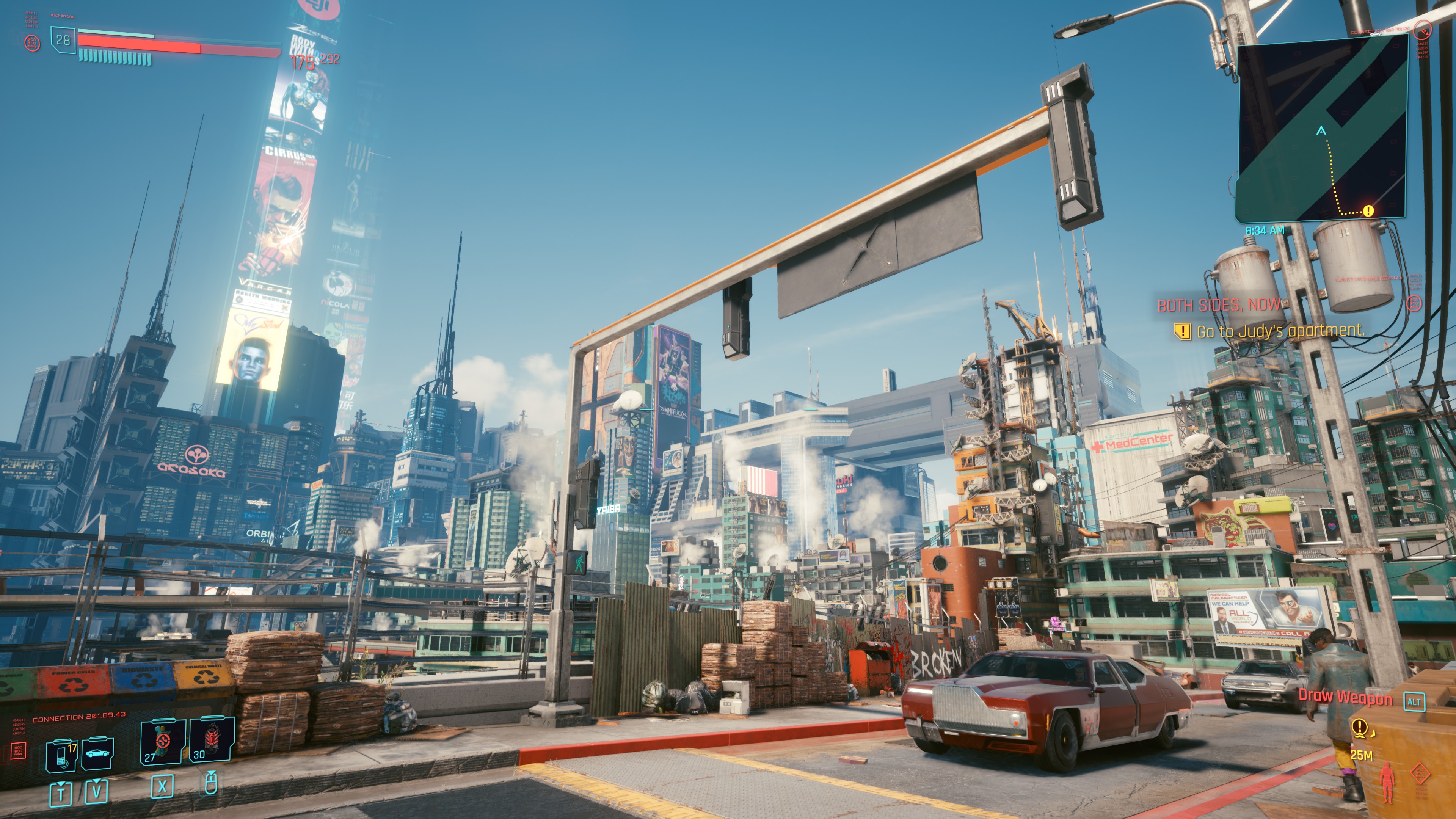
But beneath Night City’s glittering veneer is a game with significant problems, and I’m not only referring to the many bugs and technical issues that have hobbled the game’s launch on virtually all platforms. From an open-world design that feels confused and outdated, to a character progression system that simply fails to inspire, Cyberpunk is a morass of systems and ideas that, despite its strengths in other areas, never quite come together.
Inspired by Mike Pondsmith’s tabletop RPG, Cyberpunk 2077 puts you in the role of V, an ‘Edgerunner’ who exists on the fringes of society, commissioned by a network of “Fixers” to perform jobs of varying legality for clients who prefer to remain in the background. Unlike CD Projekt’s Witcher games, V is a character you create yourself, including one of several ‘Lifepaths’ that affects both your introduction to the game, and V’s general perspective of the world.
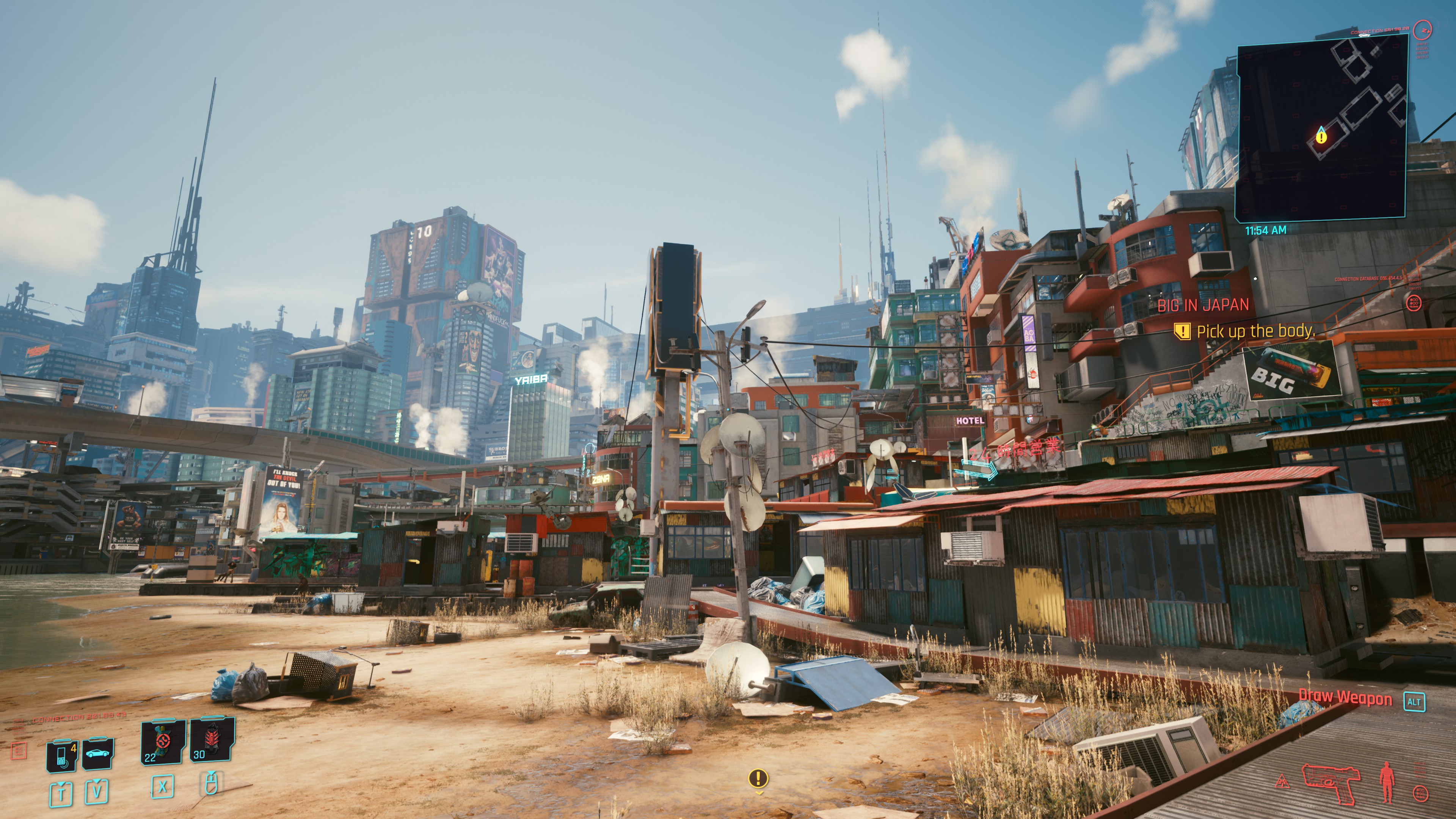
For my playthrough I opted for the ‘Nomad’ background, as it’s the only one that starts outside of Night City itself. I’m glad I did, as the main “reveal” of the city that occurs a short way into the first act hits you with both barrels. From V’s apartment, you weave through the concrete maze of a megastructure before entering an elevator which seems to go down forever. Then, moments later, you’re out into the glaring sunshine and the densely packed crowds of central Watson, while chittering crosswalks and blaring car horns fill the audio.
It’s a truly stunning moment (at least, on PC it is), and it’s far from the only one I experienced while wandering around CD Projekt’s breathtaking vision of a future metropolis. Indeed, for the first few hours I actively avoided travelling by car, instead strolling along the pavements and taking in the sights. I walked through the vibrant and ramshackle slums of Kabuki down to the waterfront, where you get an exquisite view of the skyscrapers of Japantown, an up the dusty slopes of North Oak, where you can view the city’s Panorama in full.
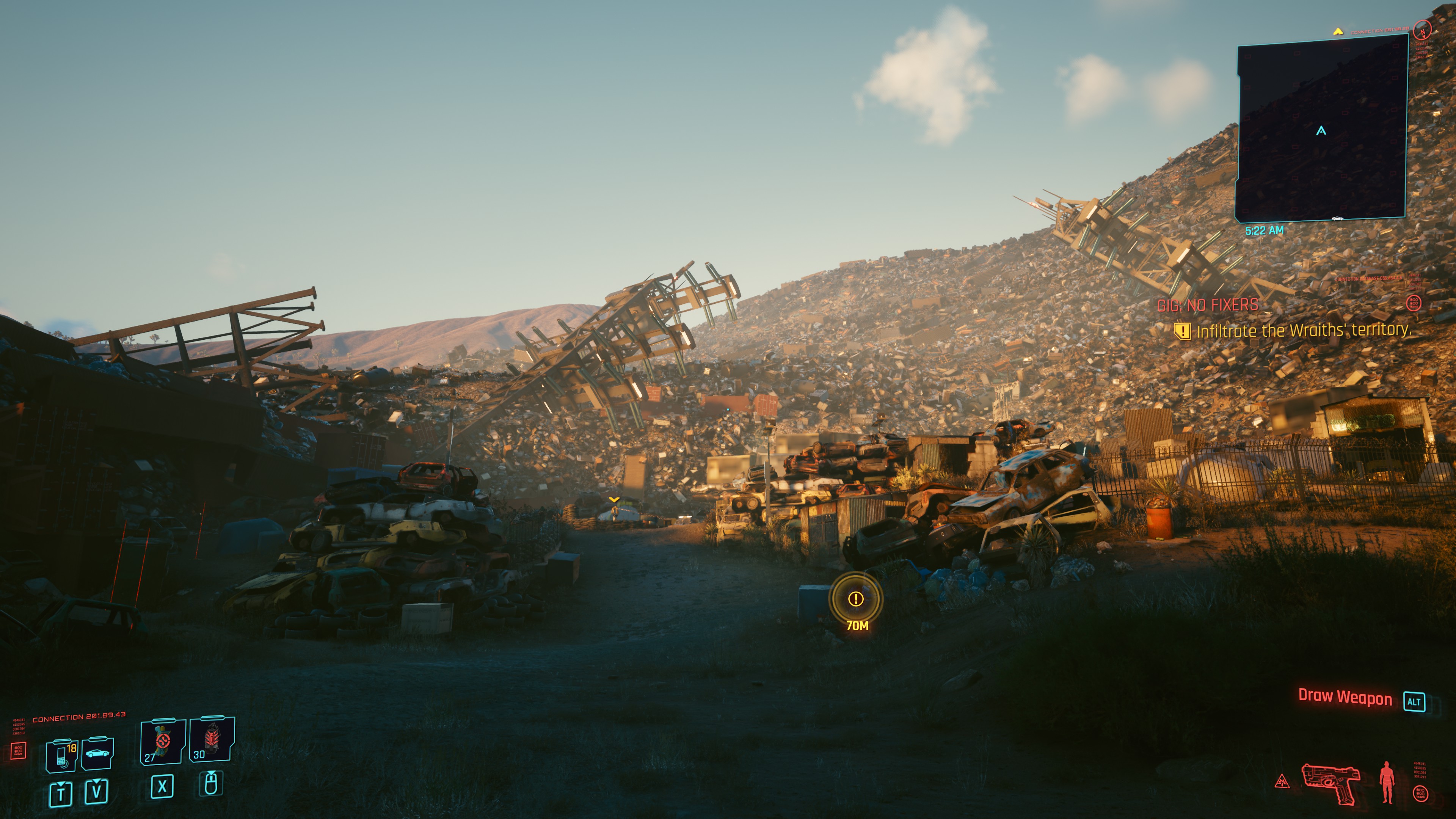
Night City is frequently a beautiful place, but it’s also one skiing down the rubbish heap of decline, quite literally. On the outskirts of the city you’ll find hills of trash and junk stretching off to the horizon. Like the Witcher 3, Cyberpunk has an eye not just for the picturesque, but for squalor and decay. Up in Northside, hordes of smoke-belching factories turn the sky to rust, while the hedonistic malls and resorts of Pacifica have been abandoned by its wealthy benefactors, left to be torn apart by gangs in scene reminiscent of the underrated shooter Bulletstorm.
At this point I’m tempted to say something trite like “The best character in the game is the world”. As with the Witcher 3, however, this isn’t necessarily the case. Cyberpunk’s opening act sees V chasing the score of a lifetime, as they attempt to steal some highly advanced tech from one of Night City’s most powerful corporations. Naturally, things don’t quite go to plan, and the remainder of the game sees V trying to extricate himself from the mess he’s landed himself in.
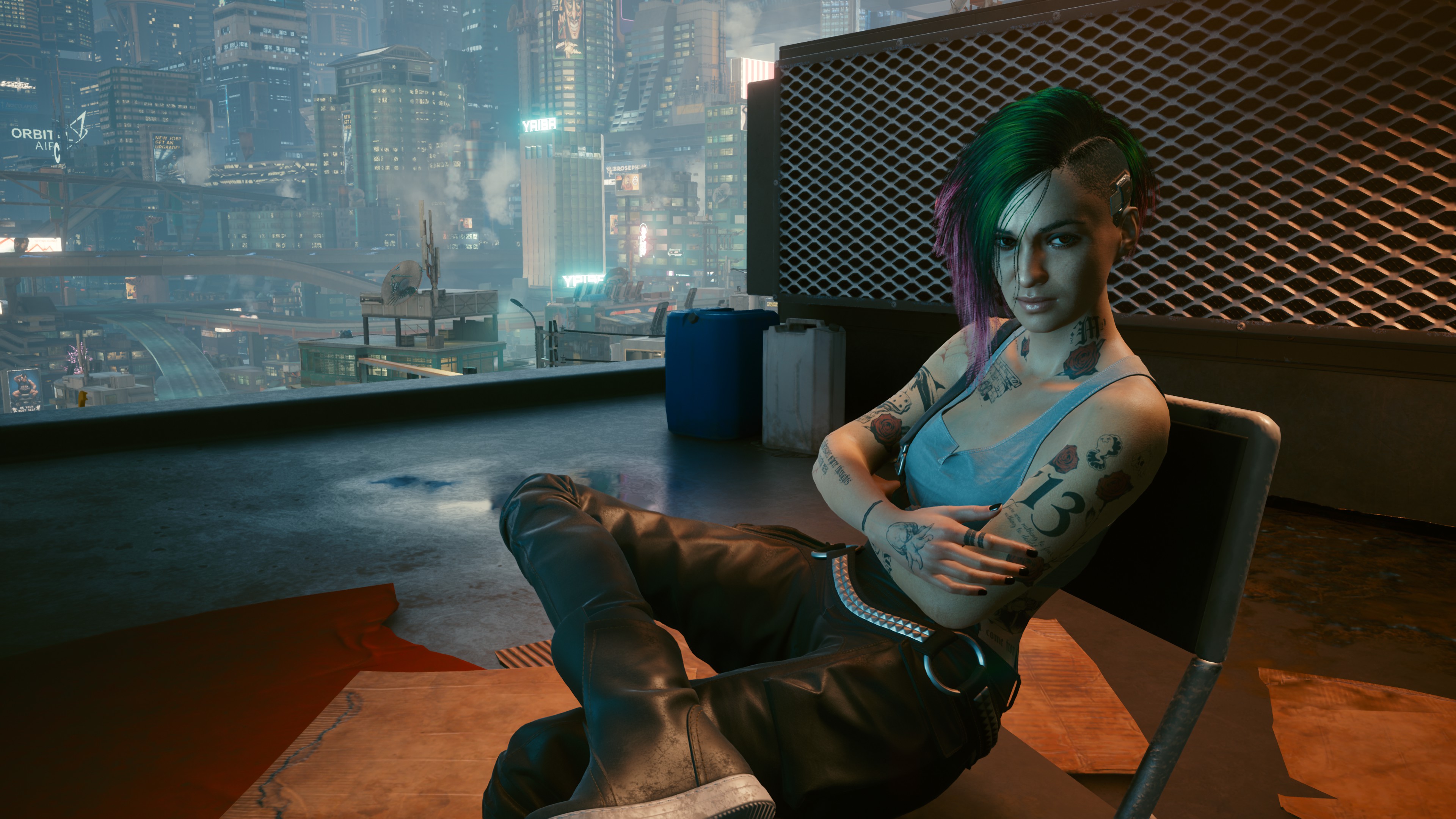
Cyberpunk’s story is more intense and faster paced than the Witcher 3, taking place across a smaller timescale with more immediate story beats than the Witcher’s sweeping epic. The missions are a mix of pulpy-detective work and high-stakes infiltrations and heists. The former generally involve a blend of finding and talking to characters, smaller-scale infiltration missions, and “Braindance” sequences, where you scan through footage of a person’s memories for clues, much like the photo-scanning scene in Deckard’s apartment during Blade Runner. The larger scale missions combine intense action with carefully scripted narrative, the closing mission of act 1 being a particular highlight.
Crucially, Cyberpunk’s story maintains this tempo without losing sight of the characters at the heart of its tale. Like the Witcher, it has an uncanny knack for the quiet and the intimate, whether you’re grabbing a bite to eat with your pal Jackie Welles at a food stall in Watson, or chatting with your braindance editor Julie Alvarez in her studio beneath Lizzie’s Bar. One of my favourite characters is Panam. An-ex Nomad with a serious chip on her shoulder, I found her hostile and irritating at first, to the point where it affected my dialogue choices, but the arc involving her and her former Nomad clan is superbly written. Keanu Reeves is also excellent as prize arsehole Johnny Silverhands, though more interesting is how the game uses him, which is extensive and reaches far beyond the main story.
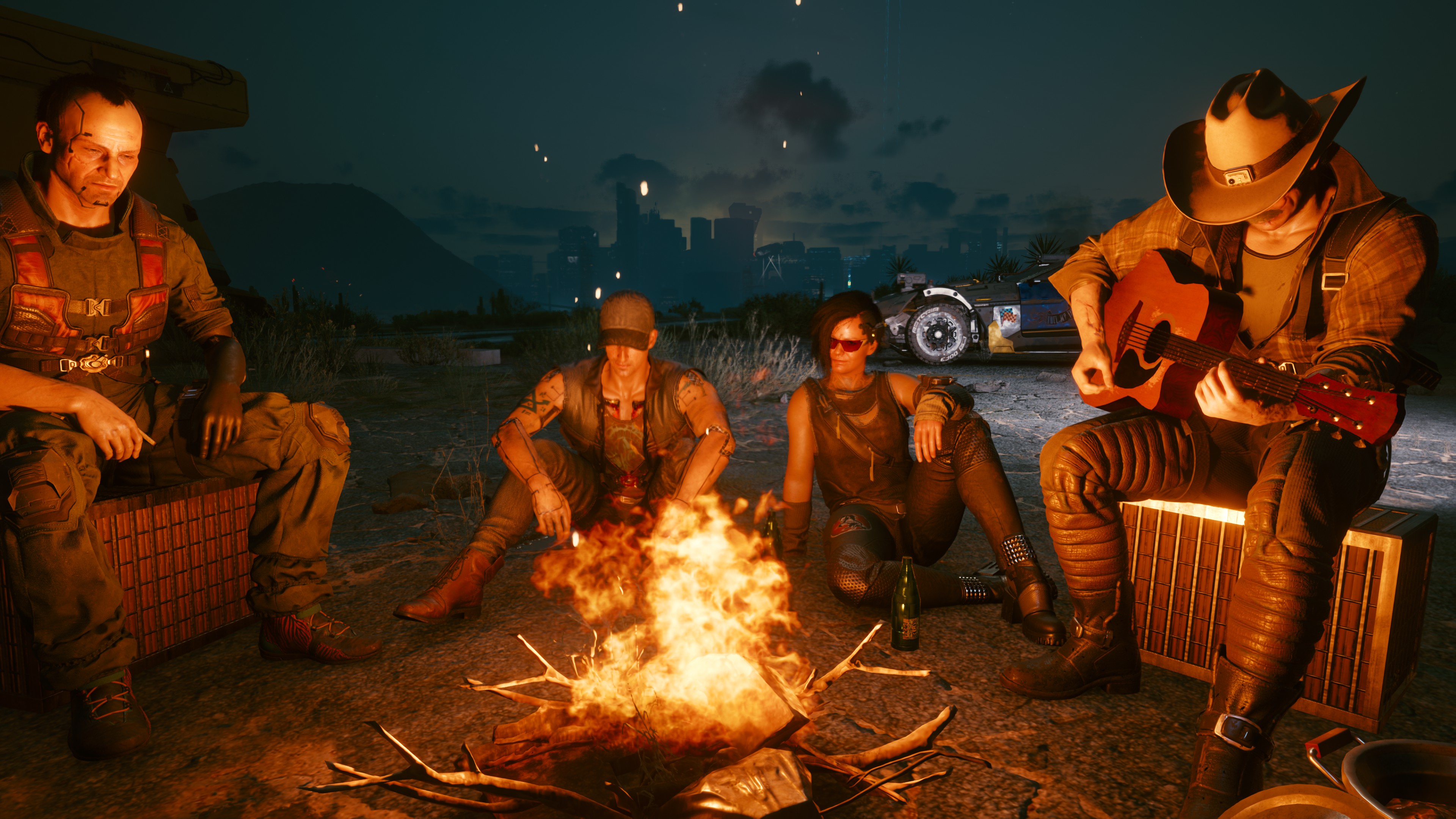
Clearly, CD Projekt has lost none of its talent for writing and characterisation. Outside of the main story, however, that talent doesn’t get the same chance to shine as it did in the Witcher 3. There are only a handful of “Proper” side-missions framed around specific characters or ideas. To the game’s credit, they are well designed and highly involved, ranging from a classic hard-boiled murder mystery to a fantastically odd mission where you need to retrieve a fleet of rogue AI taxis, one of the most well-dressed fetch quests I’ve ever played. One of the most interesting side-quests is also one of the darkest, which sees you and detective River Ward searching for his missing nephew. It’s a superbly told murder mystery in reverse. The killer has already been caught, and instead you’re looking for where he hid his victims, hoping then when you find River’s nephew, he’s still alive.
Nearly everything else takes the form of “gigs”, quickfire missions that typically involve retrieving an object from a building, be it an object or a person. There are dozens of these scattered across Night City, and while a few of them hooked me in with an interesting concept, most of them are disposable and oddly impersonal for a CD Projekt game.
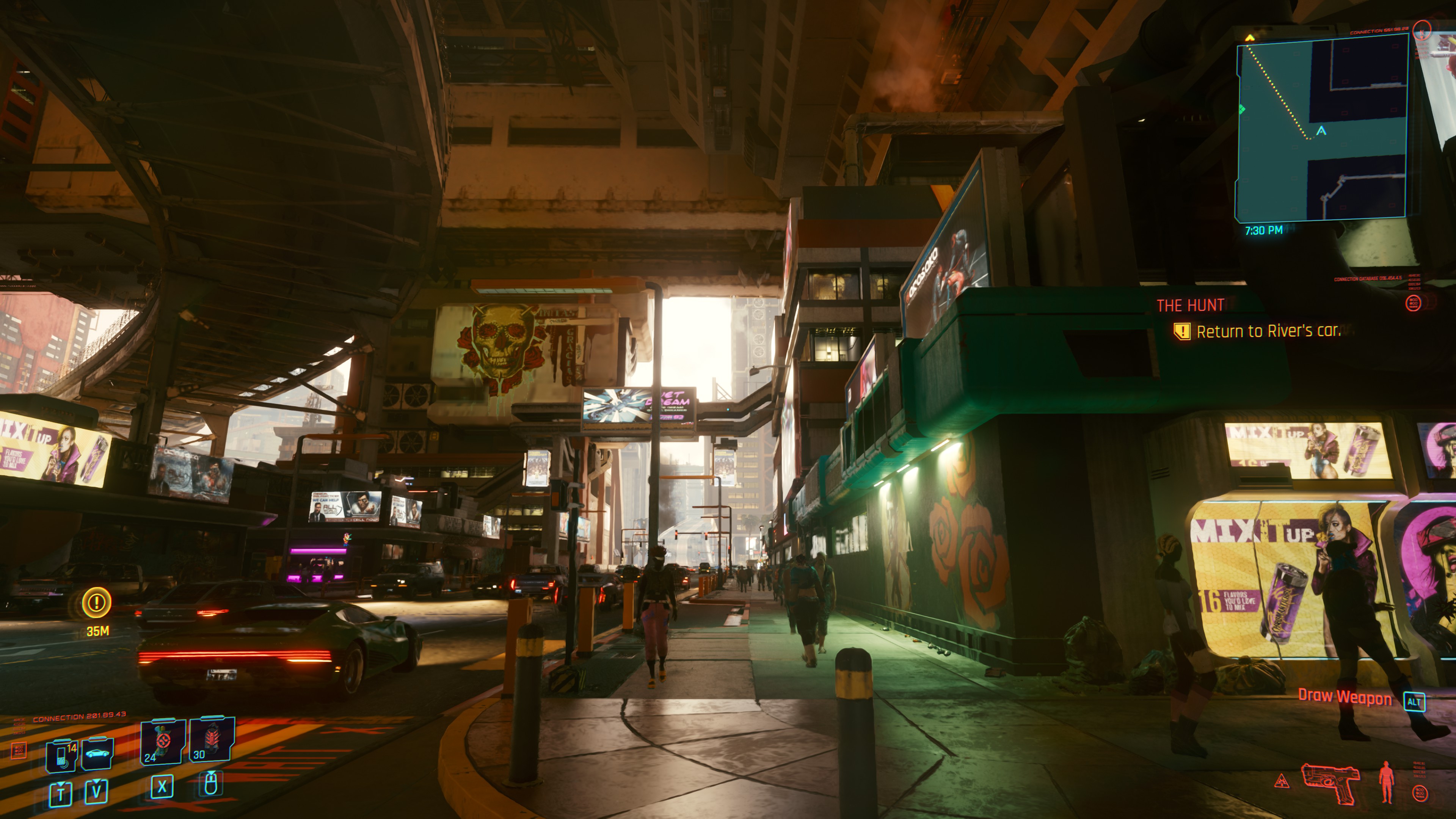
The reason these gigs exist is to cater the systems half of Cyberpunk, which is inspired primarily by games like Deus Ex. Most missions let you approach them through either combat or stealth. After an underwhelming start, Cyberpunk eventually reveals itself to be competent at both. Guns in particular are punchily designed, feeling weight and lethal (though not always that futuristic). In the main game, I became particularly fond of a bolt-action sniper-rifle that kicked like a kangaroo and could take an enemy’s head off in a single shot. But my favourite weapon is Johnny Silverhands’ pistol, a ferocious hand-cannon that tears literal chunks out of enemies. Melee weapons are less good. While I enjoyed pulling out a katana at first, there’s little nuance to melee combat, while the ‘Mantis Blades’ revealed in the very first Cyberpunk trailer are one of the least interesting weapons in the game.
Primarily though, I played Cyberpunk as a stealth game. Initially, I thought this might be a huge mistake. Not only was I constantly getting spotted, many of the core stealth mechanics, like nonlethal takedowns, are clumsy and unsatisfying. That changed somewhat when I upgraded my character’s hacking chip to hold more “Quickhacks”, abilities that let you mess with enemies and the environment. After this, I could remotely deactivate cameras and even turn off enemy ocular devices, temporarily blinding them while I slipped past. Some missions also offer an incentive for approaching them stealthily, making me feel like it was worth going to the extra effort.
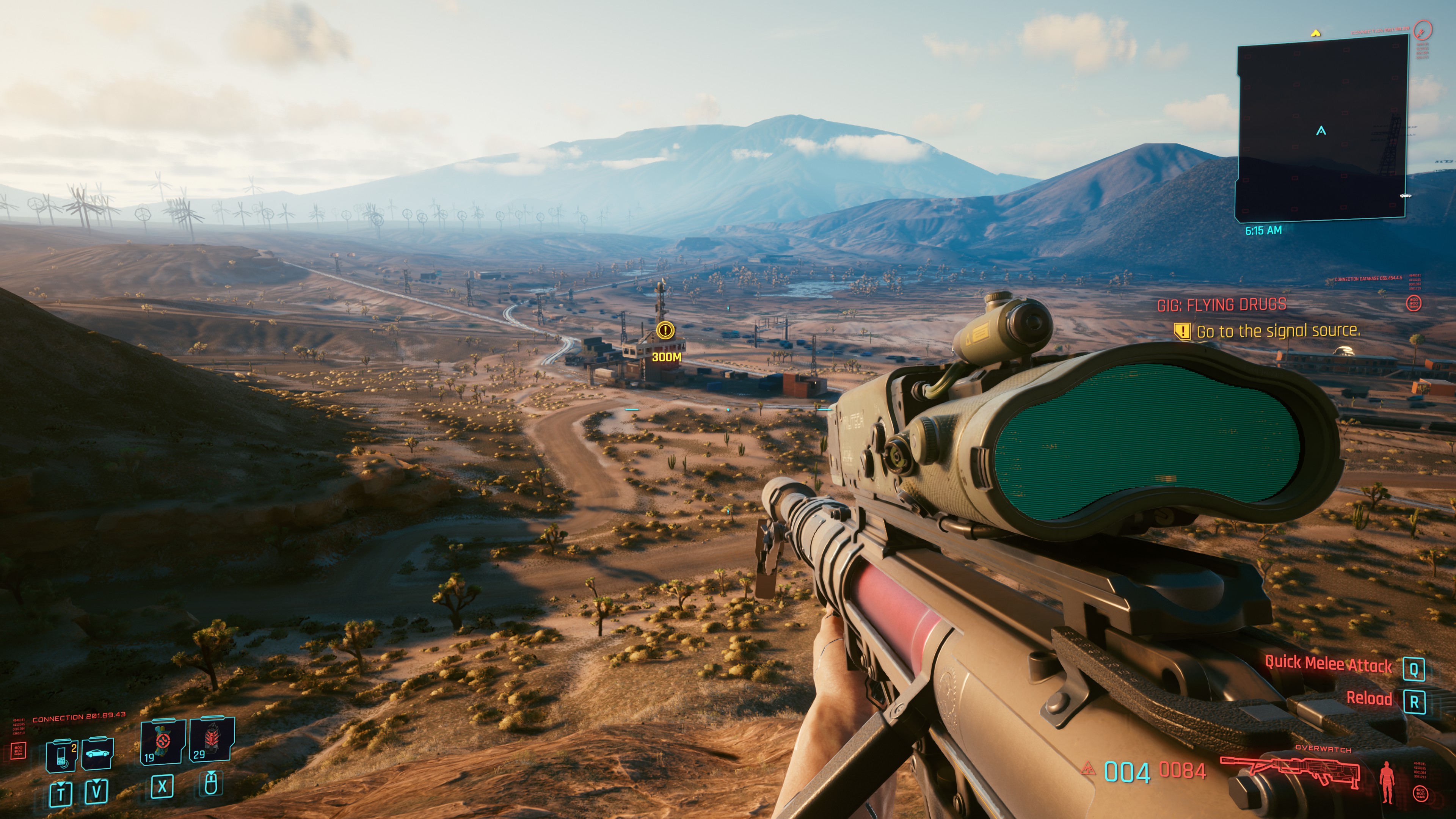
In the end Cyberpunk is a competent shooter and an adequate stealth game. However, in both cases it offers nothing that you haven’t seen before. The core of Cyberpunk also suffers from two key problems. Firstly, character progression is terribly designed. Few of the available skill upgrades are in any way exciting, with most of them enabling you to perform key abilities either slightly better or slightly faster. The stealth skill tree is particularly poor. Its most exciting unlockable is the ability to throw a knife. Indeed, Cyberpunk has a tendency to dress up abilities that are bog-standard fare in any open world game. One of the quickhacks you can unlock is the ability to “whistle” to distract an enemy, so I can only assume that lips don’t exist in the year 2077.
The problems with the skill system don’t end there. You can’t unlock abilities in a relevant skill until you have levelled that skill up, which you do by using that skill (such as levelling up stealth by performing stealth takedowns). This might sound interesting in theory, but in practise it hamstrings your ability to tailor your character. The Athletics tree features some of the more useful skills, but for the life of me I couldn’t figure out how to level that skill up. I think it involves running around a lot, which I hardly ever needed or wanted to do.
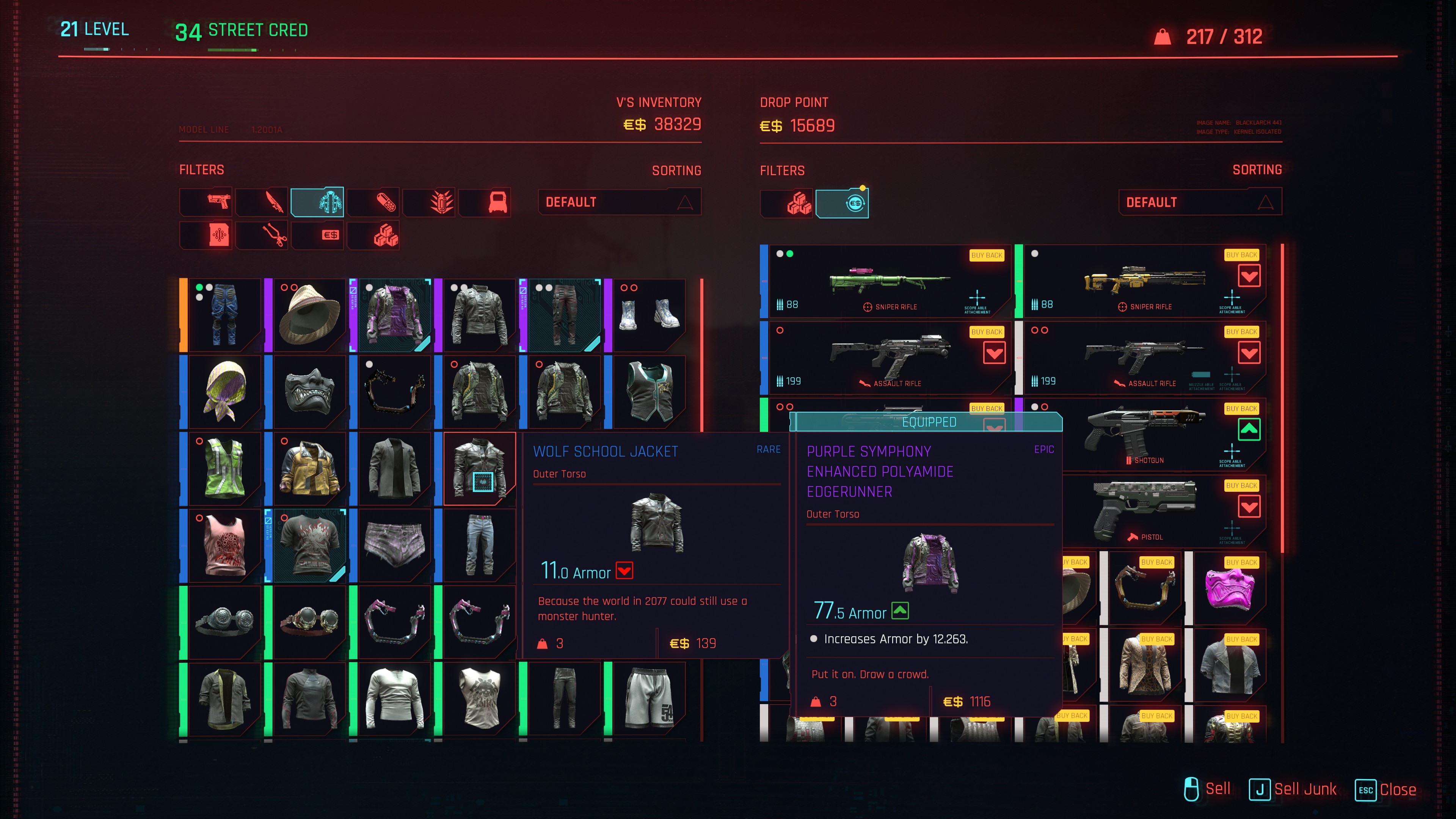
The Cyberware menu is similarly confusing and underwhelming. It works similarly to Deus Ex’s augmentations system, but again, the vast majority of available upgrades boil down to minor stat boosts. There are a couple of exciting ones, like being able to install a rocket launcher into your arm, but compared to the superb range of abilities seen in the Deus Ex and Dishonored games, Cyberpunk’s mechanical take on human enhancement is comparatively pedestrian.
When they’re around, the story and characters compensate for this, although it’s worth noting the main story often doesn’t make much use of these systems. At times it plays more like a Call of Duty campaign, with highly railroaded sequences. They’re strong enough that it doesn’t matter all that much (I could happily let the game’s NPCs drive me around Night City all day). But it also suggests that CDPR aren't all that confident in the game mechanics they’ve designed.
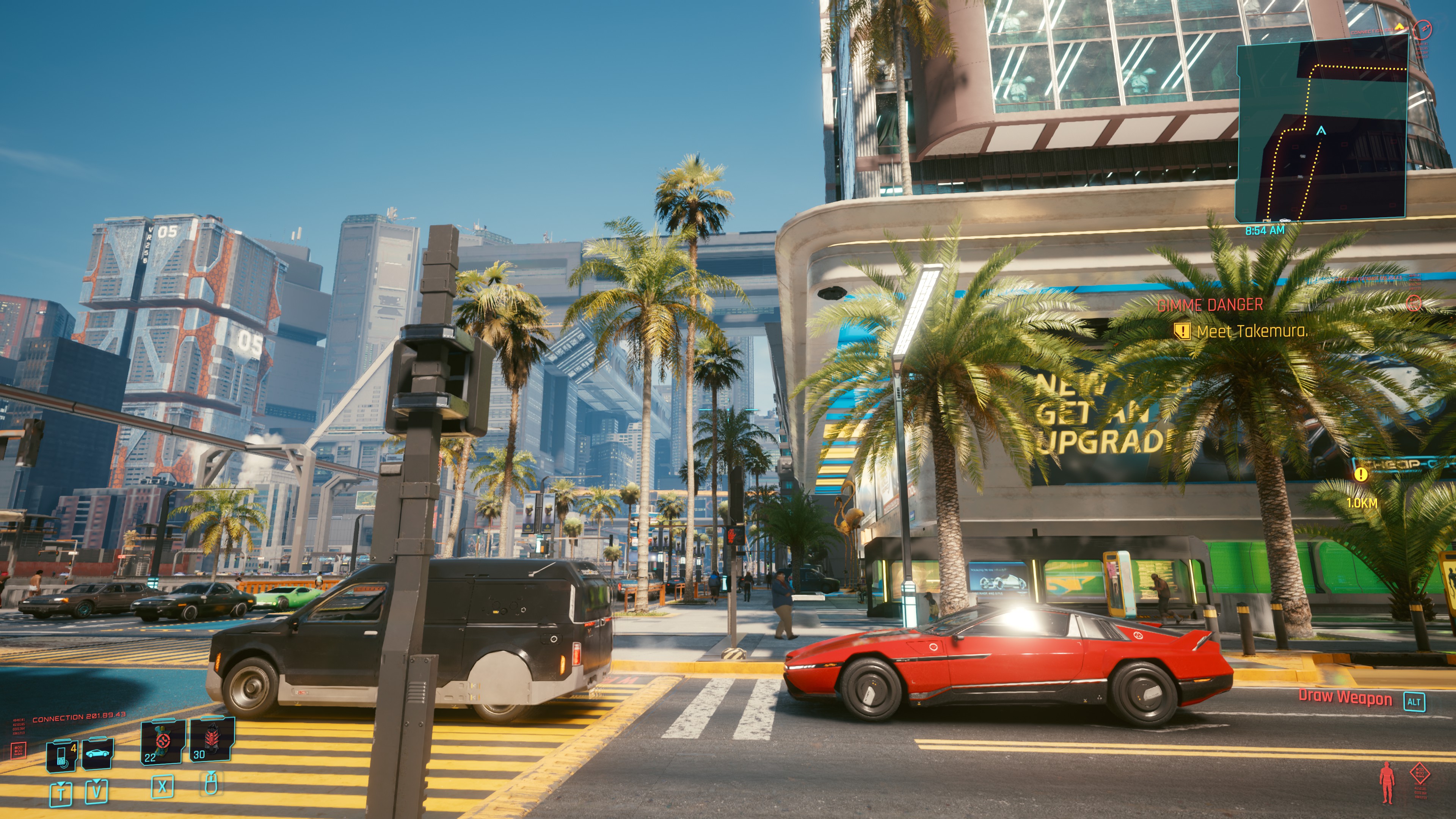
Without that narrative backbone, it isn’t long before the side-gigs start to feel achingly repetitive. With creative play limited and the story threads much weaker, there are only so many prefab apartments and industrial complexes you can raid before they blur together. Even the more tangible rewards for doing these quests are underwhelming. Environments are stuffed with so many lootable items that’s it’s hard to pinpoint what’s actually valuable, while the monetary rewards for completing quests are meagre compared to the cost of cyberware upgrades and tech. If you want to buy new upgrades or vehicles, you really have to grind these missions out.
Indeed, the open world balancing is out of whack with the main story, which you can quite easily complete with most of the map and most of your skill trees unexplored. You’ll go fifteen to twenty hours without seeing an interesting side mission, then suddenly they appear almost simultaneously at the tail end of the second act. Vehicles are particularly under-utilised. With the exception of the Nomad introduction, there are only a handful of moments in the story where vehicles are used for anything more than a mobile location for a conversation.

This brings me onto a slightly more speculative point. It feels like there’s a lot of stuff missing from Cyberpunk. Outside of the initial character creation, there’s no ability to customise your character’s appearance beyond different outfits. There’s also no vehicle garage or vehicle customisation. There are loads of different factions, but there’s no underlying faction system or faction-aligned missions. The world itself feels highly static. NPCs don’t have routines, and don’t react to your presence beyond running away if you initiate combat. The police will attack you if you commit a crime, but there’s little scope for car chases or any other kind of dynamic world action.
To be clear, ideas and content are cut from games all the time. It’s a natural part of the creative process. But in Cyberpunk, the seams are quite visible. The weird balancing and conflation between side missions and gigs is a big clue that CDPR intended the game to include more substantial side-content, but for reasons unknown opted to remove it.
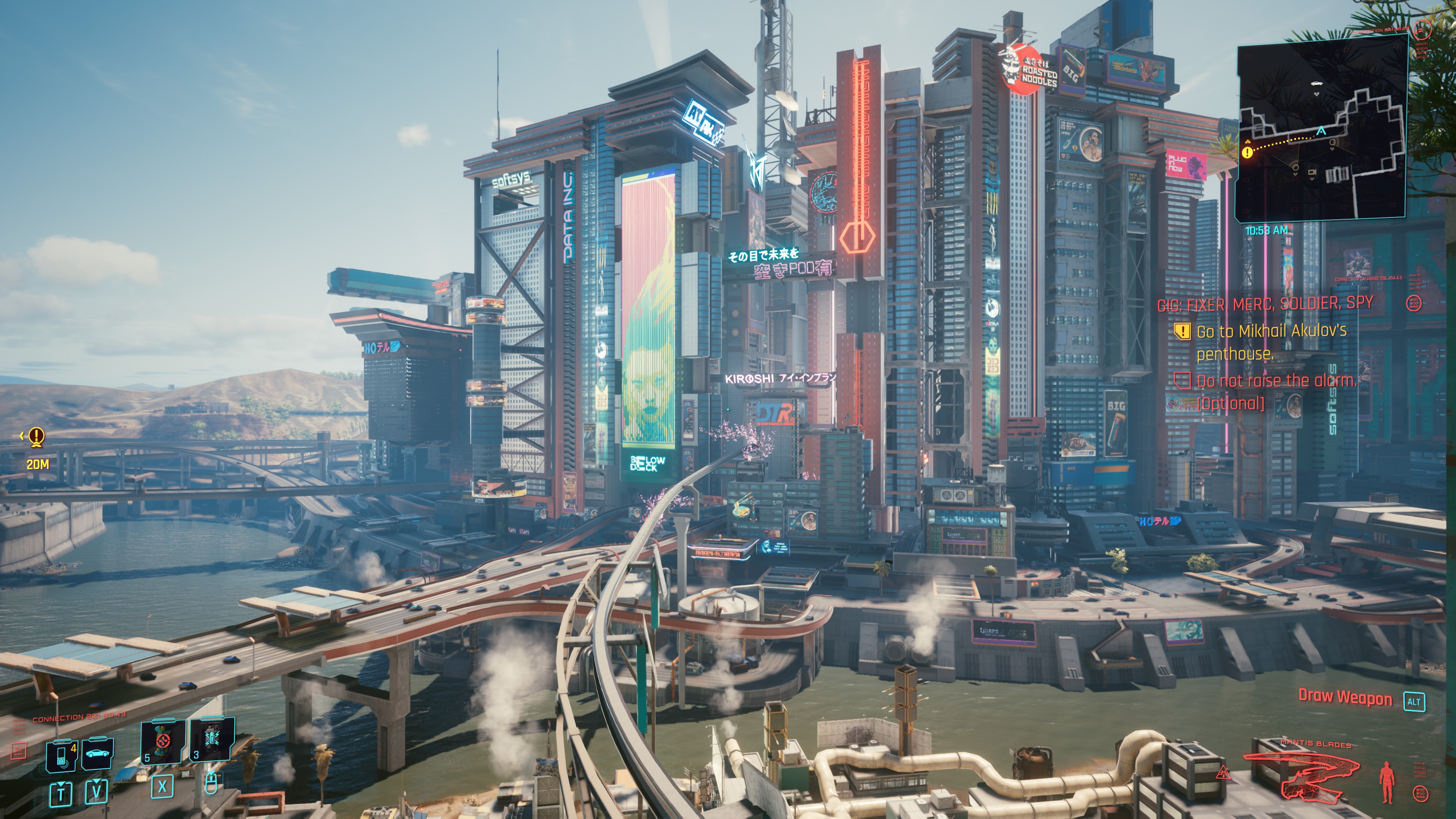
Finally, there are the technical issues. Fitting as it may be, Cyberpunk is one glitchy-arse game. I’ve seen objects floating in mid-air, people floating in mid-air, vehicles buried halfway in the ground like they got struck by an orbital bombardment. Animations will frequently fail to play, meaning characters will either stand in the default T-pose or skid motionlessly across the ground (I’ve seen the latter occur even in the main story). Some of the weirdest bugs revolve around your automated car, which when summoned can spawn in the strangest places, including inside other cars. Once, I summoned my car in the Badlands and it spawned halfway through a fence, juddered around a bit, then exploded, killing me.
Mercifully, I didn’t encounter anything completely game breaking. But the performance issue I encountered were both more frequent and more problematic. Despite playing on the recommended specs for my RTX 2080 Super, the quality of performance varied wildly. Anything from entering a cutscene to using photo mode could result in a permanent drop in framerate. Spending too long in the menus also seemed to obliterate otherwise stable performance, necessitating a restart.
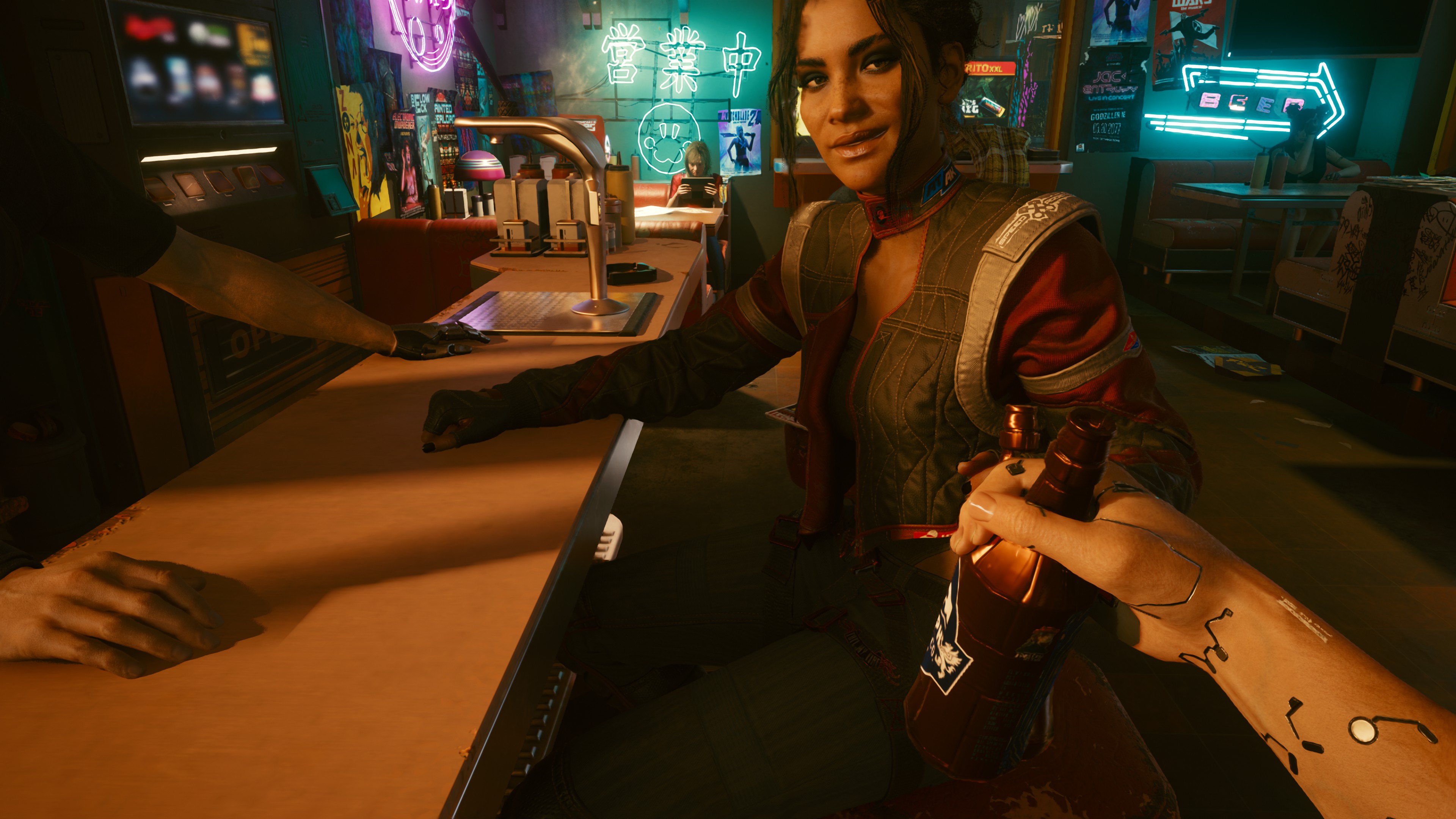
It makes you wonder whether it was all worth it. Cyberpunk’s development has been mired in controversy, from stories of relentless crunch to get the game out on time, through accusations of transphobia and a general insensitivity towards certain groups and subject matters. The launch period has been even worse, with the game failing to include vital warnings about epilepsy triggers and CDPR being downright dishonest about the state of the PS4 and Xbox One versions of the game. All the goodwill the company established between the Witcher and the Witcher 3, the lovable outsider competing with the more established major publishers has been blown in the last couple of years.
It’s deeply unfortunate, because that CD Projekt is still visible in Cyberpunk. While its surface may often be gauche and crass, the stories that lie underneath are anything but. It’s a game with a lot to say, about the nature of identity and family, and the lengths individuals must go to simply to survive in cruel, neglectful, and brutally hyper-capitalist world. But that voice verges on being drowned out by the myriad technical issues, the deeper mechanical inconsistencies, and the very conditions under which the game was created. It’s a game about the suffocating systems of hard capitalism, itself suffocated by those very systems. Perhaps, then, CDPR should listen harder to its own voice, because every now and again, it makes some incisive points:
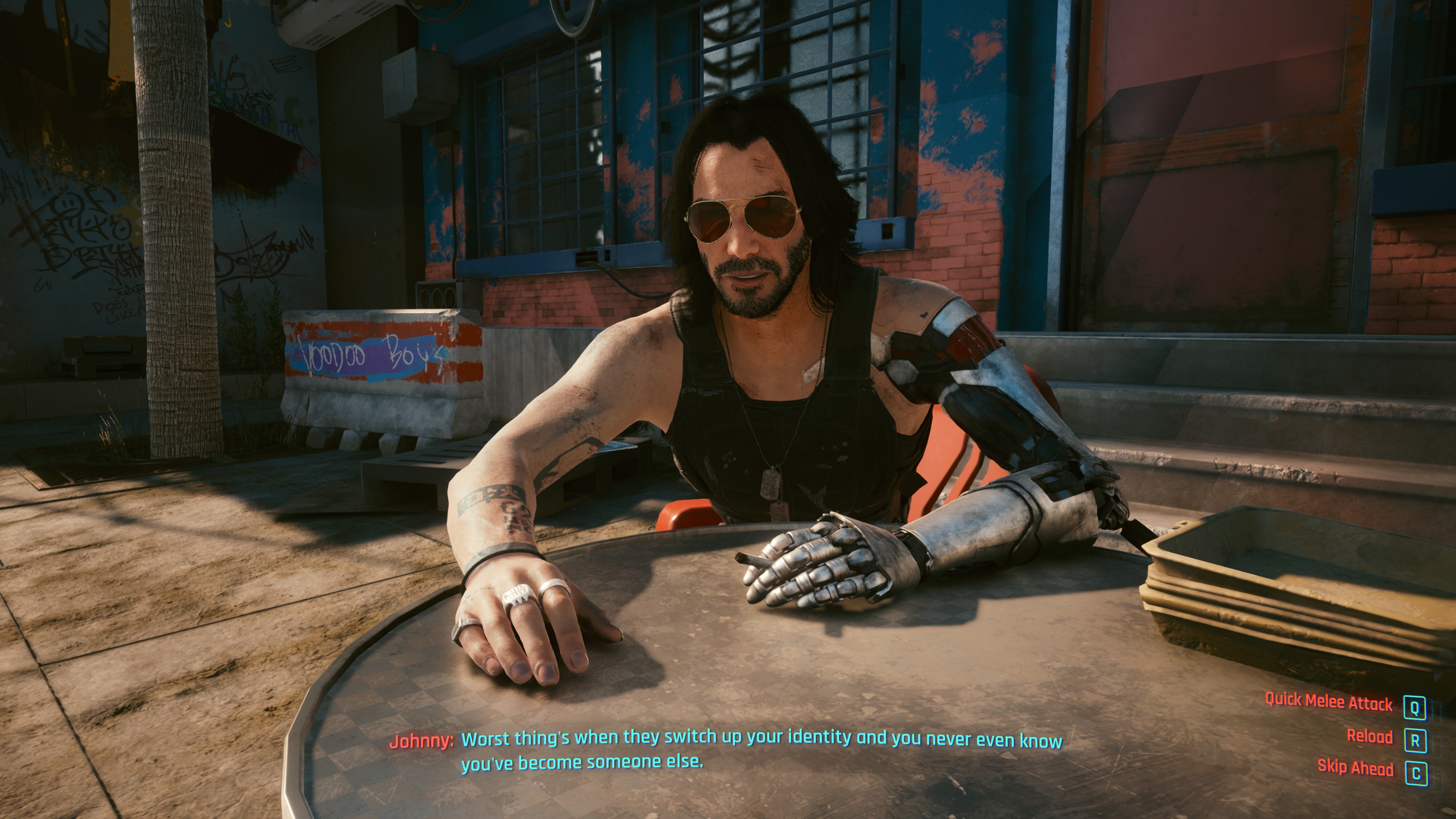
Thanks Johnny.

MSI MPG Velox 100R Chassis Review
October 14 2021 | 15:04






Want to comment? Please log in.